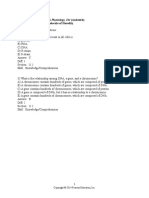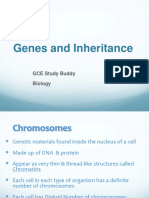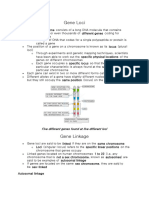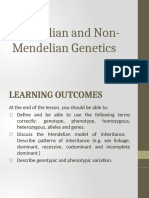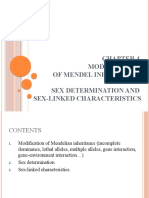0 ratings0% found this document useful (0 votes)
28 viewsB.B Genetics in Transfusion Medicine
B.B Genetics in Transfusion Medicine
Uploaded by
Abode AlharbiGenetics and molecular biology play an important role in immunohematology. Genes determine characteristics that are passed from parents to offspring. Chromosomes contain DNA and genes. Mitosis and meiosis are types of cell division. Phenotype is the observable expression of genes, while genotype refers to an individual's genetic makeup inherited from parents. Alleles are variations of a gene. Population genetics examines how genes are inherited and interact within groups. Different patterns of inheritance include autosomal dominant, autosomal recessive, X-linked dominant, and X-linked recessive.
Copyright:
© All Rights Reserved
Available Formats
Download as PDF, TXT or read online from Scribd
B.B Genetics in Transfusion Medicine
B.B Genetics in Transfusion Medicine
Uploaded by
Abode Alharbi0 ratings0% found this document useful (0 votes)
28 views13 pagesGenetics and molecular biology play an important role in immunohematology. Genes determine characteristics that are passed from parents to offspring. Chromosomes contain DNA and genes. Mitosis and meiosis are types of cell division. Phenotype is the observable expression of genes, while genotype refers to an individual's genetic makeup inherited from parents. Alleles are variations of a gene. Population genetics examines how genes are inherited and interact within groups. Different patterns of inheritance include autosomal dominant, autosomal recessive, X-linked dominant, and X-linked recessive.
Original Title
(1) B.B Genetics in Transfusion Medicine
Copyright
© © All Rights Reserved
Available Formats
PDF, TXT or read online from Scribd
Share this document
Did you find this document useful?
Is this content inappropriate?
Genetics and molecular biology play an important role in immunohematology. Genes determine characteristics that are passed from parents to offspring. Chromosomes contain DNA and genes. Mitosis and meiosis are types of cell division. Phenotype is the observable expression of genes, while genotype refers to an individual's genetic makeup inherited from parents. Alleles are variations of a gene. Population genetics examines how genes are inherited and interact within groups. Different patterns of inheritance include autosomal dominant, autosomal recessive, X-linked dominant, and X-linked recessive.
Copyright:
© All Rights Reserved
Available Formats
Download as PDF, TXT or read online from Scribd
Download as pdf or txt
0 ratings0% found this document useful (0 votes)
28 views13 pagesB.B Genetics in Transfusion Medicine
B.B Genetics in Transfusion Medicine
Uploaded by
Abode AlharbiGenetics and molecular biology play an important role in immunohematology. Genes determine characteristics that are passed from parents to offspring. Chromosomes contain DNA and genes. Mitosis and meiosis are types of cell division. Phenotype is the observable expression of genes, while genotype refers to an individual's genetic makeup inherited from parents. Alleles are variations of a gene. Population genetics examines how genes are inherited and interact within groups. Different patterns of inheritance include autosomal dominant, autosomal recessive, X-linked dominant, and X-linked recessive.
Copyright:
© All Rights Reserved
Available Formats
Download as PDF, TXT or read online from Scribd
Download as pdf or txt
You are on page 1of 13
Genetics and Molecular
Biology: Their role in
Immunohematology.
Yasser Hassanein,
D.H.Sc.,M.Sc., MLS (ASCP)CM
L(1)
Generalities
● Gene:
● Basic unit of heredity transferred from a
parent to offspring held to determine
some characteristic of offspring
sequence of nucleotides forming part of
the chromosome
● Genome: complete set of chromosomes
and genes inherited as a unit from one
parent
● Locus: the specific position of a gene on a
chromosome
DNA
● Chromosomes are
composed of long
linear strands of
DNA tightly coiled
around proteins
called histones
● 23 pairs
● 22 autosomal
(homologous)
● 1 sex (non-
homologous)
Mitosis
● Cell division by
somatic cells in
which the body
grows and cells are
replaced
● Diploid cells: 2N,
reproduced by
mitosis making
daughter cells
Meiosis
● Sex cell division
● Ova and sperm
are haploid (1N)
● Ensures that when
zygote formed –
back to diploid
cells (2N)
Definitions
● Phenotype: detectable expression of the
genotype (hair color) not inherited depend on
genotype and environment (A, B, AB, O)
● Genotype: the genetic makeup of individual given
by parents through reproduction (AA, AO, BB,
BO, AB, OO)
● Allele: one or two or more alternative form of a
gene arise by mutation found at some place on
the chromosome
● Homozygous: individual has identical alleles at a
locus. Genotype may be SS or AA
● Heterozygous: individual has different alleles at a
locus. Sickle cell trait (AS)
Population Genetics
●Gene Linkage: genetic traits inherited together
●Crossing-over: the exchange of materials between
homologous chromosomes result in recombinant
chromosomes
●Gene deletion: is a mutation which part of the
chromosome or sequence of DNA is missing (loss of
genetic material)
●Gene mutation: permanent change of the
nucleotide sequence of the genome of an organism,
virus,…
Population Genetics
● Trait: a distinguishing characteristic
especially of one’s personal
● Codominant: the pattern of inheritance
most frequently expressed by blood
groups genes
● Recessive : inheritable characteristic by
genes expressed only when inherited from
both parents
● Amorphic: a gene doesn’t produce any
product.
Population genetics
● Autosomal dominant: a gene on one of
the non-sex chromosome that is always
expressed even if one copy present.
● Autosomal recessive: genetic condition
appears only if individual have recessive
two copies of autosomal gene.
● X-linked dominant: genetic inheritance by
which dominant gene is carried on X-
chromosome (less common)
● X-linked recessive: mutation on X-
chromosome cause 1 x in male and 2 x in
Autosomal Dominant
Autosomal Recessive
X-linked dominant
X-linked recessive
Examples:
You might also like
- Analyzing Genetic Variation - Student GuideDocument3 pagesAnalyzing Genetic Variation - Student GuideJanesa Torres-VargasNo ratings yet
- Defy Aging - Beth BennettDocument303 pagesDefy Aging - Beth BennettEvans100% (1)
- 1 Quim Exam Model DNA The Molecule of Heredity TestBank - Basics - Bio10a - Chapter11Document20 pages1 Quim Exam Model DNA The Molecule of Heredity TestBank - Basics - Bio10a - Chapter11Karen Montaño100% (1)
- AP Biology Unit 5-Heredity: MeiosisDocument7 pagesAP Biology Unit 5-Heredity: MeiosisSam SankarNo ratings yet
- Genes and Inheritance: GCE Study Buddy BiologyDocument38 pagesGenes and Inheritance: GCE Study Buddy BiologyPeace FulNo ratings yet
- Introduction To Medical Genetics L1Document35 pagesIntroduction To Medical Genetics L1Suheel AhmedNo ratings yet
- Genetics and Evolution SUMMARY NOTESDocument6 pagesGenetics and Evolution SUMMARY NOTESPrabhNo ratings yet
- Francis Ian L. Salaver, RMT Bmls3ADocument17 pagesFrancis Ian L. Salaver, RMT Bmls3AFarlogyNo ratings yet
- Chapter 3 - Genetic Control of Cell FunctionDocument7 pagesChapter 3 - Genetic Control of Cell FunctionSADAVEJO100% (1)
- AP Bio GeneticsDocument3 pagesAP Bio GeneticsAniket BinwadeNo ratings yet
- Genetics and EvolutionDocument6 pagesGenetics and EvolutionCherry Grace Articulo DabuconNo ratings yet
- General Biology 2 Second SemesterDocument49 pagesGeneral Biology 2 Second SemesterRuthie TabanguilNo ratings yet
- Bio ReviewerDocument5 pagesBio Reviewerralphsalazar2007No ratings yet
- REV #5 - Introduction To GeneticsDocument3 pagesREV #5 - Introduction To GeneticsCatalytic AintNo ratings yet
- Documento Sin TítuloDocument11 pagesDocumento Sin TítuloAky IwnlNo ratings yet
- Chapter 13. Meiosis and Sexual Life CyclesDocument3 pagesChapter 13. Meiosis and Sexual Life CyclesYukyung ShinNo ratings yet
- MutationsDocument52 pagesMutationsgvantsaNo ratings yet
- 18 InheritanceDocument46 pages18 Inheritances1139221No ratings yet
- Chapter 5 - Reviewer - Biological PsychologyDocument6 pagesChapter 5 - Reviewer - Biological PsychologyGloriel Grace DoromalNo ratings yet
- ANAT 1053 Weekly Objectives May 2023 May 4Document52 pagesANAT 1053 Weekly Objectives May 2023 May 4abelzzinnoNo ratings yet
- Lec02 Chromosom-Sex Link 2020Document49 pagesLec02 Chromosom-Sex Link 2020aclarke0806No ratings yet
- Heredity and EvolutionDocument49 pagesHeredity and Evolutionali.igwtNo ratings yet
- Genetics (DNA)Document22 pagesGenetics (DNA)michaeldevid7890No ratings yet
- Genetics 23 24Document75 pagesGenetics 23 24Marlon CanilangNo ratings yet
- GeneticsDocument45 pagesGenetics김가온No ratings yet
- Inheritance IGCSE BIOLOGYDocument5 pagesInheritance IGCSE BIOLOGYDewan Anisha IslamNo ratings yet
- Genetics of Common DiseasesDocument57 pagesGenetics of Common Diseaseskholoud220No ratings yet
- Inborn Error of MetabolismDocument59 pagesInborn Error of MetabolismMadhu Sudhan PandeyaNo ratings yet
- Human Genetic General-1Document60 pagesHuman Genetic General-1Bidhan RegmiNo ratings yet
- Mendelian Genetics and ChromosomesDocument48 pagesMendelian Genetics and Chromosomesreginedelamarquez14No ratings yet
- Genetics RevDocument10 pagesGenetics RevWilma WagasNo ratings yet
- Bio Class TenthDocument17 pagesBio Class Tenthrohin.08.incNo ratings yet
- Genetics Part 1Document6 pagesGenetics Part 1loveiseternal2005No ratings yet
- ReproductionDocument24 pagesReproduction김동후No ratings yet
- Chromosomes: Magdalena F. Natividad, PHD Dean, School of Medical Lab Science Feu-NrmfDocument24 pagesChromosomes: Magdalena F. Natividad, PHD Dean, School of Medical Lab Science Feu-NrmfCharm Angeles100% (1)
- DNA Genes and Chromosomes 2Document29 pagesDNA Genes and Chromosomes 2shaynnnbotlogNo ratings yet
- Dasar Genetika+molekulerDocument45 pagesDasar Genetika+molekulerAGASTI MERCU SUANo ratings yet
- Basic Concept of GeneDocument6 pagesBasic Concept of Genepooja banyalNo ratings yet
- Genetic InheritanceDocument4 pagesGenetic InheritancealeeyoufateemearhNo ratings yet
- INHERITANCEDocument20 pagesINHERITANCEjgv69cjgrfNo ratings yet
- Genetics, Mitosis & MeiosisDocument7 pagesGenetics, Mitosis & MeiosisSeher Masood - 43458/TCHR/BNINo ratings yet
- BIOLS102-UOB-Chapter 11Document3 pagesBIOLS102-UOB-Chapter 11Noor JanahiNo ratings yet
- Mendelian and Non Mendelian GeneticsDocument75 pagesMendelian and Non Mendelian GeneticsColesio, Maria Elaine M.No ratings yet
- 5.-Genetics - A Review - Part 1Document27 pages5.-Genetics - A Review - Part 1Kyrby CabalquintoNo ratings yet
- Basic Concepts of Genetics, Autosomes, Allosomes, Chromosome Disorders 2023Document69 pagesBasic Concepts of Genetics, Autosomes, Allosomes, Chromosome Disorders 2023Ali MansorNo ratings yet
- Molecular Basis of GeneticsDocument32 pagesMolecular Basis of GeneticsHasanah NurmirafudinNo ratings yet
- Unit 3 Biology PDFDocument8 pagesUnit 3 Biology PDFRobin WeigoldNo ratings yet
- Inheritance BiologyDocument7 pagesInheritance BiologyGNo ratings yet
- Topic 8 Variation and GeneticsDocument45 pagesTopic 8 Variation and GeneticsrafeyNo ratings yet
- GeneticsDocument13 pagesGeneticsMarina ArvanitopoulouNo ratings yet
- Genes, Chromosomes, and Human GeneticsDocument61 pagesGenes, Chromosomes, and Human GeneticsDimo PratannaNo ratings yet
- General Genetics Notes With DR ChandleeDocument36 pagesGeneral Genetics Notes With DR ChandleeVenice CariñoNo ratings yet
- Genetics - Chapter 4 - Modification of Mendel-Extension and Modification-Sex DeterminationDocument46 pagesGenetics - Chapter 4 - Modification of Mendel-Extension and Modification-Sex DeterminationDuy AnhNo ratings yet
- Genes and Inheritance: 5090 BiologyDocument91 pagesGenes and Inheritance: 5090 BiologyAli MirzaNo ratings yet
- Genetics Reviewer. RevisedDocument9 pagesGenetics Reviewer. RevisedjennygrandeepestNo ratings yet
- Gene and InheritanceDocument2 pagesGene and Inheritanceaisumid1233No ratings yet
- Genetics: Definition: Branch of Biologic Science That Deals With Transmission of Characters From Parents To OffspringsDocument22 pagesGenetics: Definition: Branch of Biologic Science That Deals With Transmission of Characters From Parents To OffspringsCLEMENTNo ratings yet
- B. Concepts in Genetics335Document14 pagesB. Concepts in Genetics335owenspros5No ratings yet
- HeredityDocument3 pagesHeredityMerryearNo ratings yet
- Bio Presentation-1Document29 pagesBio Presentation-1mannal.rathoreNo ratings yet
- Modes of InheritanceDocument18 pagesModes of InheritancedrmanojkulNo ratings yet
- Lec 6 - Heredity & GeneticsDocument27 pagesLec 6 - Heredity & Geneticsdasshrayan343434No ratings yet
- The DNA Detective: Unraveling the Mysteries of Our Genetic CodeFrom EverandThe DNA Detective: Unraveling the Mysteries of Our Genetic CodeNo ratings yet
- Chapter 19 AnswersDocument1 pageChapter 19 AnswersdanielNo ratings yet
- Practical Lesson 2 Cultivation of Drosophila MelanogasterDocument5 pagesPractical Lesson 2 Cultivation of Drosophila MelanogasterSovietencat0% (1)
- Summary 4º ESO - Unit 3 - Genetic Information and Nucleic AcidsDocument89 pagesSummary 4º ESO - Unit 3 - Genetic Information and Nucleic AcidsPILARNo ratings yet
- Genetic TestingDocument11 pagesGenetic TestingPriyanka Patel100% (2)
- Igcse Revision ChecklistDocument11 pagesIgcse Revision Checklistapi-292005743No ratings yet
- Edexcel iGCSE Biology Section E16 Chromosomes, Genes and DNADocument2 pagesEdexcel iGCSE Biology Section E16 Chromosomes, Genes and DNACorry Sepvia100% (1)
- Squirrel Island T ClaassensDocument9 pagesSquirrel Island T Claassensapi-527913909No ratings yet
- DNA Mutation RatesDocument37 pagesDNA Mutation RatesSean Pitman, MDNo ratings yet
- TAAI2016-SnakeAIusingEAv 1 0-WebDocument8 pagesTAAI2016-SnakeAIusingEAv 1 0-WebChoudharyNo ratings yet
- ATAR Human Biology 12 Units 3Document13 pagesATAR Human Biology 12 Units 3FireAwayNo ratings yet
- Dr. Gerald Crabtree - Our Fragile Intellect, Part IDocument3 pagesDr. Gerald Crabtree - Our Fragile Intellect, Part ILeakSourceInfoNo ratings yet
- Ames TestDocument16 pagesAmes TestAnirudh AcharyaNo ratings yet
- Pre-AP BIOLOGY - 2015-2016 Monday Tuesday Wednesday Thursday FridayDocument12 pagesPre-AP BIOLOGY - 2015-2016 Monday Tuesday Wednesday Thursday FridayNoah LoyaNo ratings yet
- Dynamics of Evolutionary StasisDocument13 pagesDynamics of Evolutionary StasisJohann Piñón SalgadoNo ratings yet
- Heredity, Inheritance and Variation: Time Frame: 1 Week Name: Grade and Section: DateDocument5 pagesHeredity, Inheritance and Variation: Time Frame: 1 Week Name: Grade and Section: DateAngie ReblandoNo ratings yet
- The Chicken or The EggDocument2 pagesThe Chicken or The EggOoi Lize100% (1)
- Mini Mock 1 P4Document13 pagesMini Mock 1 P4moutaz bedeweyNo ratings yet
- Fixing Gene Expression-Central Dogma and Genetic Medicine-FillalbeDocument6 pagesFixing Gene Expression-Central Dogma and Genetic Medicine-FillalbeElizabeth WardenNo ratings yet
- Aqa Biology Inheritance Variation Evolution Graspit Gcse AnswersDocument15 pagesAqa Biology Inheritance Variation Evolution Graspit Gcse Answershaidermaryam050No ratings yet
- Bone and Developement BookDocument321 pagesBone and Developement BookGiannis Iakovou100% (4)
- 12-4 Gene Regulation and MutationDocument26 pages12-4 Gene Regulation and Mutationapi-342334216No ratings yet
- Welcome To Biol 3301 Genetics: InstructorsDocument37 pagesWelcome To Biol 3301 Genetics: InstructorsAZGG75286No ratings yet
- CHAPTER 3 Heredity and VariationDocument63 pagesCHAPTER 3 Heredity and VariationLopak TikeNo ratings yet
- HEREDITY AND VARIATION Grade 10Document111 pagesHEREDITY AND VARIATION Grade 10MARVIN COMAYASNo ratings yet
- Earth and Life Science 1ST GradingDocument8 pagesEarth and Life Science 1ST Gradingyapkiko01No ratings yet
- Rabbits and The Specious Origins of Domestication: ForumDocument4 pagesRabbits and The Specious Origins of Domestication: ForumainoNo ratings yet


